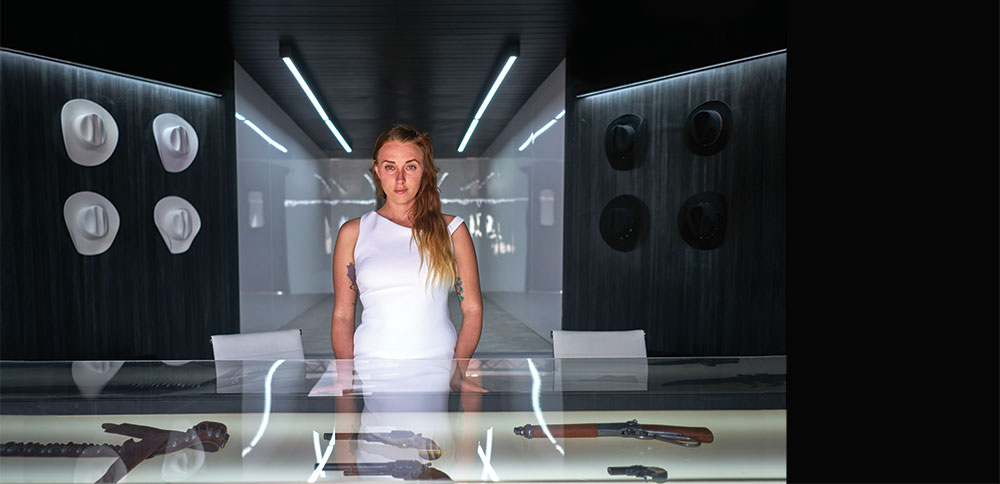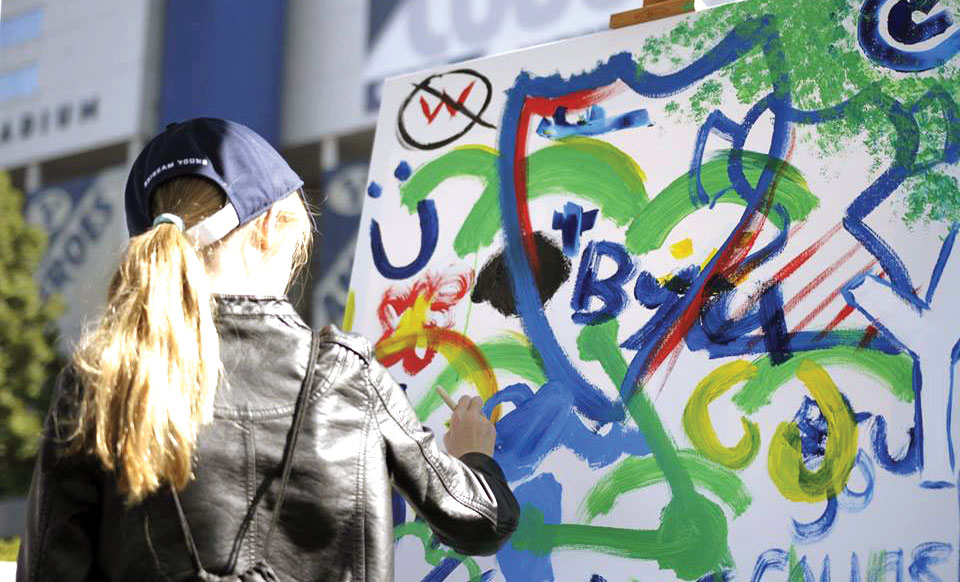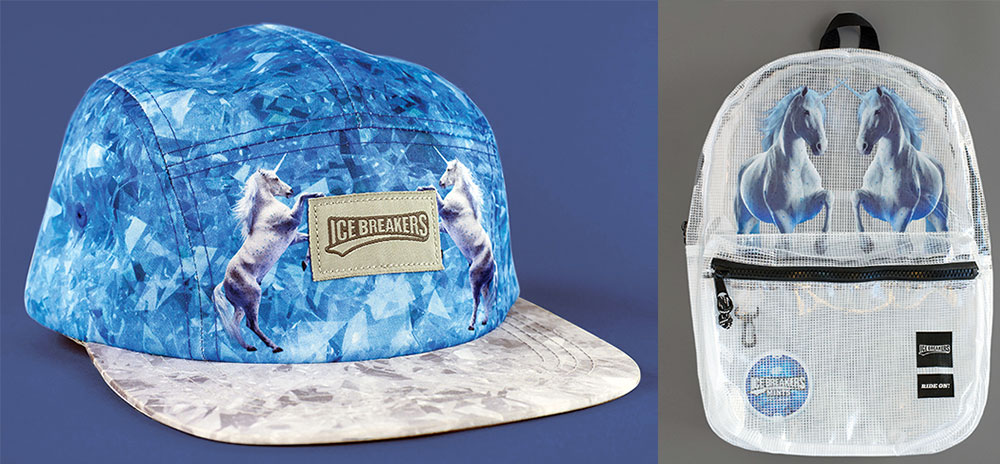Strategy May 02, 2018
Creating Connections With Experiential Marketing
How can your promo make an emotional connection? Just step inside the dazzling world of experiential marketing.
Two sets of cowboy hats — some white, some black — hung on the wall. The visitors were given one or the other, but only after their color choice was determined by a series of probing questions, such as “I believe in destiny.” After donning the Stetson and passing through a white-walled room, they embarked on a half-hour’s journey before finally reaching their destination: a dusty Western town.
There, the visitors were free to wander, whether it was grabbing a drink from the Mariposa Saloon or interacting with the “Hosts” going about their business. Intrigue coursed throughout the sunbaked streets – a bank robbery, a love triangle, a desire for revenge – and it all erupted in a tense stand-off in the town center, guns and threats brandished willfully.
 The “portal room” was the first stop of the immersive Westworld experience at South by Southwest.
The “portal room” was the first stop of the immersive Westworld experience at South by Southwest.
Fans of Westworld won’t be surprised to learn the name of this town: Sweetwater. Except this wasn’t an episode from the highly anticipated second season of the hit HBO show. It was an actual experience at South by Southwest – an elaborate “brand activation” that took five months to build, employed 60 actors and required a script of 444 pages. Over the span of three days in March, roughly 4,000 guests passed through the two-acre town. Some came for an hour or two; others stayed all day.
>>Don't Miss! Experiential Marketing As An Effective Team-Building Exercise
Created by HBO and ad agency Giant Spoon, the Westworld experience was the buzz of Austin, TX, during the popular SXSW festival. “People waited in the standby line for 10 hours. And when they came back, they said it was worth it,” says Patrick Jong, director of experiential marketing for Giant Spoon. “That’s a testament right there.” The enthusiasm of participants radiated across the web and social media. “This elaborately constructed interactive experience transported fans of murderous robots and AI intrigue into their favorite show in a way no high-tech VR experience ever could,” raved Vanity Fair.
Video
See examples of experiential marketing right here!
This is just the most recent eye-popping example of branding’s buzziest trend: experiential marketing. The conceit is immediately understandable: crafting a memorable experience “with the idea that you want to engage a consumer and create an emotional connection,” says Ted Church, founder of Anthem Branding (asi/122353), a distributorship based in Boulder, CO.
Jamie Braaten, director of business marketing and partnerships at General Electric, sees experiential marketing as the ability to physically bring a brand to life and give users an opportunity to experience, feel and engage with it in a way they aren’t able to do otherwise. “I think physical experiences are kind of at a premium right now,” Braaten says. “Brands are seeing it as an opportunity to cut through the noise in digital.”
>>More! Secrets of the Dazzling Westworld Brand Experience
The numbers agree. A survey by Freeman found that nearly 60% of chief marketing officers value brand experiences for their ability to create ongoing relationships with key audiences. According to a recent EventTrack survey, 74% of potential customers are more inclined to purchase a product or service after engaging in an experiential marketing campaign. In total, the Association of National Advertisers forecasts that experiential marketing is growing annually by 6.7% to over $50 billion.
Patrick Hadley has noticed an uptick in the use of experiential marketing over the last five to 10 years. “Thirty years ago, we had TV, radio, magazines, newspapers, billboards, etc., and we could predict – or at least we thought we could – consumer behavior. People sat down and watched the evening news and were forced to watch commercials,” says the CEO of Hadley Media, which specializes in creating experiential marketing campaigns. “Now, people DVR and skip commercials, and watch movies on phones and get news from social media shares. A clever experiential campaign can break through all of it and, if successful, will give consumers an experience that they’ll share with millions of people.”

But experiential marketing isn’t solely about creating a lasting memory. The physical interaction of the event creates the opportunity to hand out promotional products and take away something tangible. Because of that, Danny Rosin says those in the promotional industry need to become familiar with the concept if they aren’t already. “I think experience marketing is here to stay,” says the co-owner of Brand Fuel (asi/145025), based in Morrisville, NC. “Because promotional products are a physical medium people often love to receive, there will always be an opportunity to have them be a part of experiential marketing in person.”
>>The Inspiration Behind Brand Fuel’s Fun, Crazy Brand Experiences
Even with the popularity of experiential marketing, it’s folly to believe that just putting on a live event with well-stocked promos will make it a rousing success. By following this checklist of must-haves, you can create a brand moment that people will hold onto for the rest of their lives.
1. Make It Fun
It’s the first item on Rosin’s list. “Fun is contagious,” he says. “And while fun won’t necessarily help you sell more, fun will bring people together to allow you to capture their attention and engage them – and then build community around your brand. After that happens, you should consider if it feels right to ask for a prospect’s business.”
Fun is exactly what Brand Fuel had in mind when teaming with digital incentive supplier MediaTree (asi/70303) and event planner Attended Events to create its SWAG Lottery Machine. In this case, SWAG stands for Surprising Wondrous Amazing Giveaway.
The “machine” in question is a photo booth-like structure with three customizable sides and a curtain covering the back. Users insert a “swag ticket” and pull a lever on the front of the box, and the machine magically dispenses a promotional giveaway. (In reality, there’s a human operator inside doling out the promos.)
Brand Fuel makes these machines available for rent at any number of interactive events, such as trade shows, product launches and sporting events. The machine comes with an optional travel case with wheels for customers who need to move the box from one location to another. Brand Fuel will even volunteer to have a member of its team man the booth if needed.
Rosin says Brand Fuel used this for its own purposes during a recent trade show, in which it gave away Brand Fuel-logoed digital reward cards in the shape of miniature records.
The goal of the SWAG Lottery Machine is to give potential customers a fun experience they’ll remember and tell their friends about – which, of course, is what marketing is all about. “We’re convinced that experiential marketing, if done right, can be directly related to helping humanize a brand,” says Rosin.
2. Create an Emotional Connection
Experiential marketers understand a simple rule of human nature: People tend to remember their most emotional experiences the best.
“To engage with a brand vs. purely watching content on a screen, it just sparks a different experience for them and triggers emotional responses and connections,” Braaten says.
“Humans recall peak experiences more than average ones,” adds Rosin. “If we want people to recall our brand, we must deliver positive, memorable and engaging experiences.”
Brand Fuel remembered this truth when creating its Paint for Swag promotion. The concept is simple: Event attendees randomly draw a piece of paper from a bowl that includes a word or phrase associated with an end-user’s brand, and attendees interpret that word or phrase through painting on canvas using colors associated with the brand. The result is an abstract piece of art that can be displayed anywhere.
 Republic Wireless and Brand Fuel hosted Paint for Swag events that let participants artistically interpret phrases associated with the Republic brand – and walk home with a unique keepsake.
Republic Wireless and Brand Fuel hosted Paint for Swag events that let participants artistically interpret phrases associated with the Republic brand – and walk home with a unique keepsake.
Logoed giveaways associated with the Paint for Swag theme – such as art journals, paper pads, colored pencils, Sharpies, puzzles and mini canvases – are often paired with the event.
Republic Wireless has held Paint for Swag tailgate parties on a college campus to promote Relay, a screenless walkie-talkie-like mobile device that allows family and friends to talk to each other one-on-one or as a group.
“The tailgate experience is often localized to the friends and family you attend with, and we loved the idea of connecting and uniting all attendees through the creation of an art piece that represented their fandom,” says Barbara Sharnak, Republic Wireless’ director of brand and product marketing. “This was a meaningful way for us as a brand to embody the spirit of true connection that we strive for in everything we do.”
Best of all, Sharnak says children, who are the primary intended users of Relay, were the most enthusiastic participants, and parents loved the opportunity to see their kids engaged in such a setting. “Relay is all about celebrating and enabling screenless childhood experiences,” Sharnak says, “so to see it happen through this activation was a home run.”
Republic is a huge proponent of experiential marketing in part because it taps into the brand’s mission to “enable personal connection outside of the digital space.” But beyond that, Sharnak loves the ability to powerfully harness emotion and create loyalty and brand awareness in a single interactive event. “We have a Maya Angelou quote painted in one of our conference rooms: ‘At the end of the day, people won’t remember what you said or did. They will remember how you made them feel,’” she says. “It’s easy for a brand to say something, but you must bring your mission to life in order to be successful.”
3. Tie Promos to the Experience
For experiential marketing, the best promotional items are always going to be tied thematically to the event.
“When a promotional item can really feel organic to the experience, instead of a totally random grab, then that’s pretty great,” Braaten says.
The buzzed-about Westworld experience at SXSW had its own signature promotional product: the high-quality cowboy hats that visitors received before they traveled to the town. “We wanted everyone to be walking around South by Southwest with the cowboy hats,” says Giant Spoon’s Jong. “Everyone knew that was Westworld. We didn’t even need to put something on the outside.” Giant Spoon did put a custom liner on the inside (with a hidden Easter egg for fans), and had other keepsakes, including coins used at the Mariposa bar and personalized letters for all arriving guests.
Other brand activations this year at SXSW took a similar approach. Visitors to the Roseanne pop-up dined at the Lanford Lunchbox (the restaurant that main character Roseanne Conner operates) and received branded can coolers as they drank Canoga Beer, the show’s fictional brew. Others had the chance to sit on the show’s iconic couch, and received sublimated blankets printed with the signature quilted pattern of the blanket in the show.
Jong’s approach with experiential giveaways is simple: they need to be well-integrated to the experience and capture interest. “We want to make sure that people are going to be showing it off,” he says. “We want to create some FOMO.”
Braaten says tailoring the promotional item to the event, rather than giving away random items that don’t directly tie in to the experience, will help create the emotional attachment companies need in order to generate brand loyalty. After all, according to that EventTrack survey, 80% of experiential marketing attendees say live demonstrations and free samples significantly help define their purchasing decision.
“When there’s a badass swag bag, people are all for that,” Braaten says. “When there are opportunities to think uniquely about how something can be engrained organically into what you’re doing, it becomes much more meaningful.”
Distributors who understand that connection and can creatively convey it, instantly have a leg up. “To pitch me promotional products,” says Braaten, “and show the ability to really get the brand and be creative with whatever it is we’re building or doing, that would be a win.”
4. Offer Useful Products
Along with fitting the event, experiential promos soar when they provide a useful function and fit the wants and needs of those in attendance.
Crankworx is a series of annual mountain-biking events that take place in multiple locations around the world. The events naturally attract sponsors that are major players in the biking world, including SRAM, a national bike components company. For the most recent Crankworx event in Whistler, BC, SRAM asked Anthem Branding to help provide promotional items as part of a unique experience.
Anthem created SRAM-logoed apparel such as trucker hats, hoodies and other warm, stylish items biking enthusiasts actually use during Crankworx. The experiential element? SRAM transformed an existing Whistler retail store into its own promotional shop and sold the items there during the two-week event. Proceeds from each sale went to the World Bicycle Relief charity.
 Recipients of this merch from Ice Breakers and Anthem Branding were encouraged to post their #UnicornMoment on Instagram and Snapchat.
Recipients of this merch from Ice Breakers and Anthem Branding were encouraged to post their #UnicornMoment on Instagram and Snapchat.
“They invited people who were coming through during the event to check out the collection we produced, and SRAM donated the proceeds to its charity, which was a really cool way for people to engage with the brand,” Church says.
Thanks to Anthem, SRAM was not only able to give attendees a memorable experience, but outfit customers with apparel they would actually wear during the event. “For us, that’s what we do,” says Church. “We really help companies with their brand messaging and create an emotional connection, and we try to do it in the most authentic way possible.”
There are scores of useful promotional products, but if it’s not a fit with the brand and target audience, the opportunity is wasted. “I think the traditional approach of logo-slapped products misses the mark,” says Church. “You have to take a different approach these days to engage with that consumer in an authentic way.”
5. Make a Social Media Push
A primary mission of any experiential marketing effort should be to provide an experience users will talk about on social media.
Per EventTrack, 34% of consumers are inclined to make a post about an experiential marketing promotion on one or more of their social media pages. While the appeal of experiential marketing isn’t limited to a single demographic, Hadley says younger people (15- to 34-year-olds) are more likely to make your campaign go viral. “Snapchat users create over 1 million ‘snaps’ per day, so from a total impression and reach point of view, a younger demographic will reach more people,” he says.
With the right product and audience, any promo can be a social media success. For example, Anthem’s SRAM collection – and in particular, the trucker hats – were a huge hit on social networks.
It helps even more to push recipients to social media (and for brands themselves to post content from the event). One of Anthem Branding’s most successful campaigns was targeted toward millennials when it teamed with Ice Breakers to help college-aged customers celebrate their #UnicornMoment – a milestone achievement in their lives – and share that moment through an Instagram and Snapchat campaign. “Each piece of apparel in the collection helped millennials discover their breakthrough moment. We did that successfully by creating unique items,” Church says.
Anthem created a collection of unicorn-themed Ice Breaker promo products that included a see-through custom backpack with a full-sublimated unicorn, plush blanket, tall unicorn bobblehead and unicorn T-shirt that included the words “I Believe in Me” above the Ice Breakers logo. These items were given away along with packs of Ice Breakers via “street-team activations” at college campuses with instructions for how recipients can share their #UnicornMoment through social media.
For the recent 2018 Olympic Winter Games in PyeongChang, Ice Breakers (which is owned by The Hershey Company, a Team USA sponsor) also assembled a number of athletes under the banner of “Team Unicorn.” The athletes shared their own #UnicornMoments leading up to the Olympics and encouraged Ice Breakers users to do the same.
Even with encouragement, users wouldn’t post on social media if the items weren’t deemed cool enough to be shared. “Any execution should have elements that make a real connection with consumers – something that makes people want to share with others,” Hadley says. “It needs to make them feel good about the brand.”
Shane Dale is a contributing writer for Advantages.
